Last week in northern Utah a pair of Swainson’s Hawks mated right in front of me. I’ve seen it happen fairly often over the years but this time they were reasonably close, I had good light, an unobstructed view and my camera was ready. I couldn’t believe my good fortune.
All images are presented in the order they were taken.
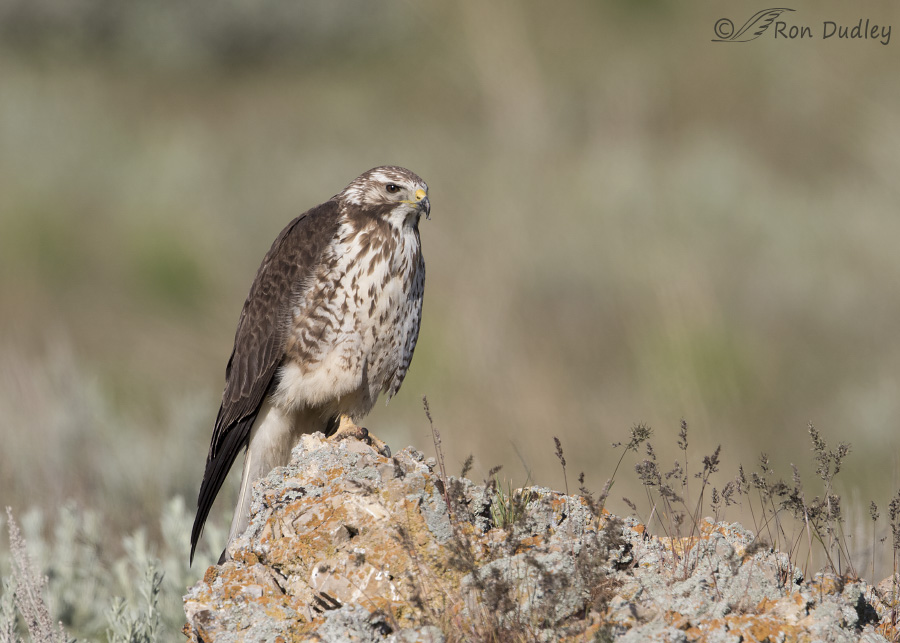
But I sure didn’t know it was coming. I was photographing the young female while her mate was perched on a power pole some distance away when suddenly…
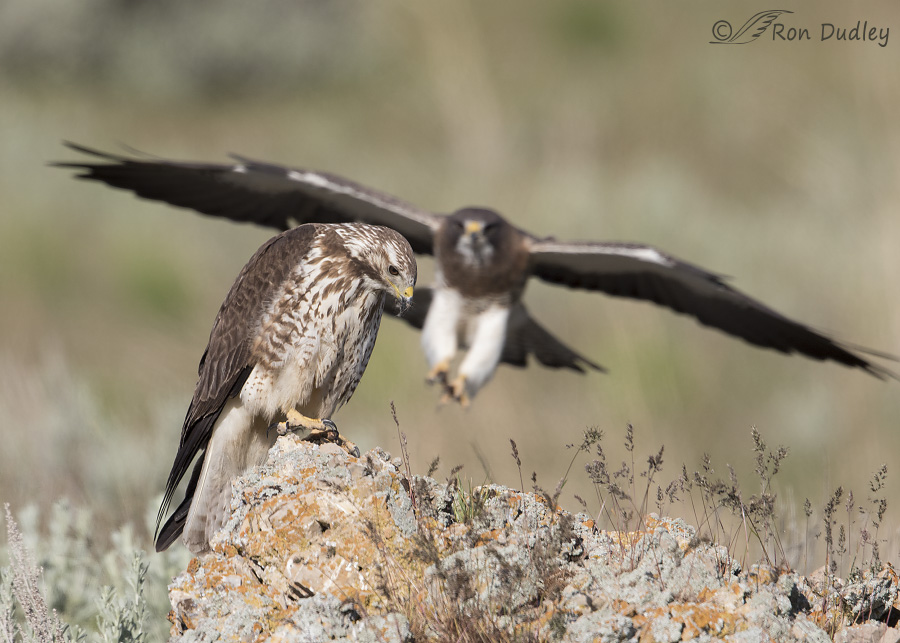
the male appeared in my viewfinder and he was coming in fast. At this point the female had already assumed a submissive posture with her head down.
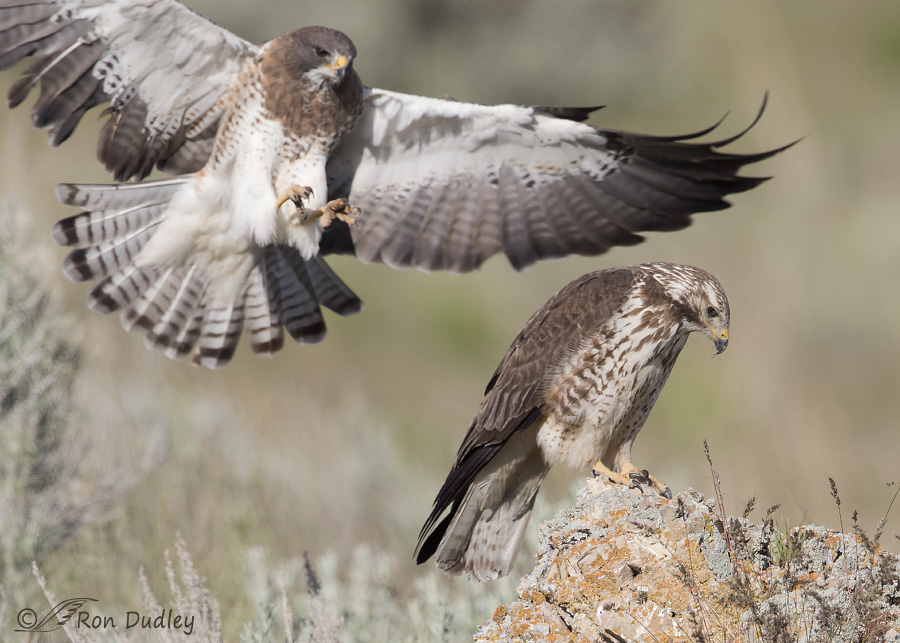
The male curled around to my left so he could land on her back.
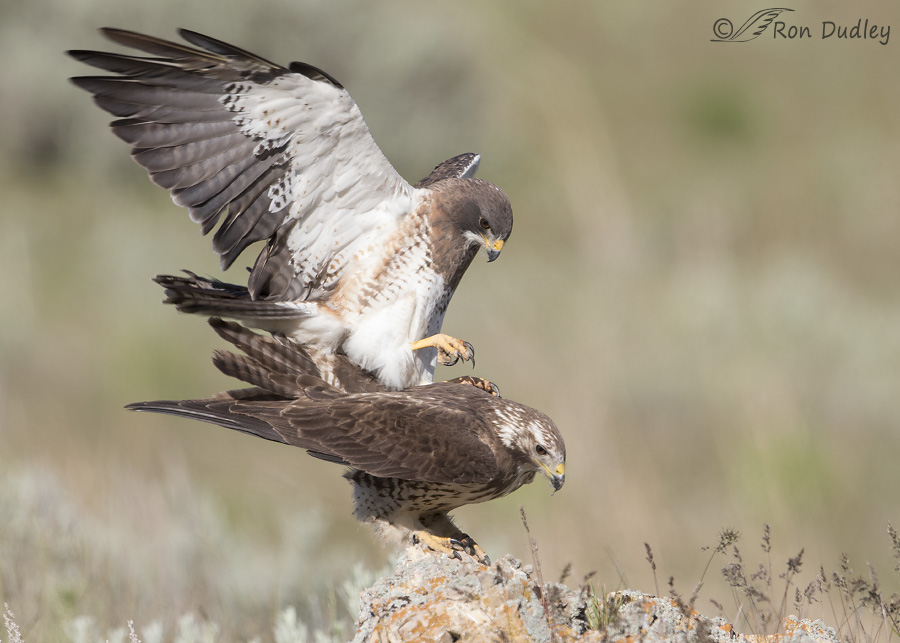
Touchdown, but it wasn’t a perfect landing. Instead of landing on the center of her back he landed to the left of center.
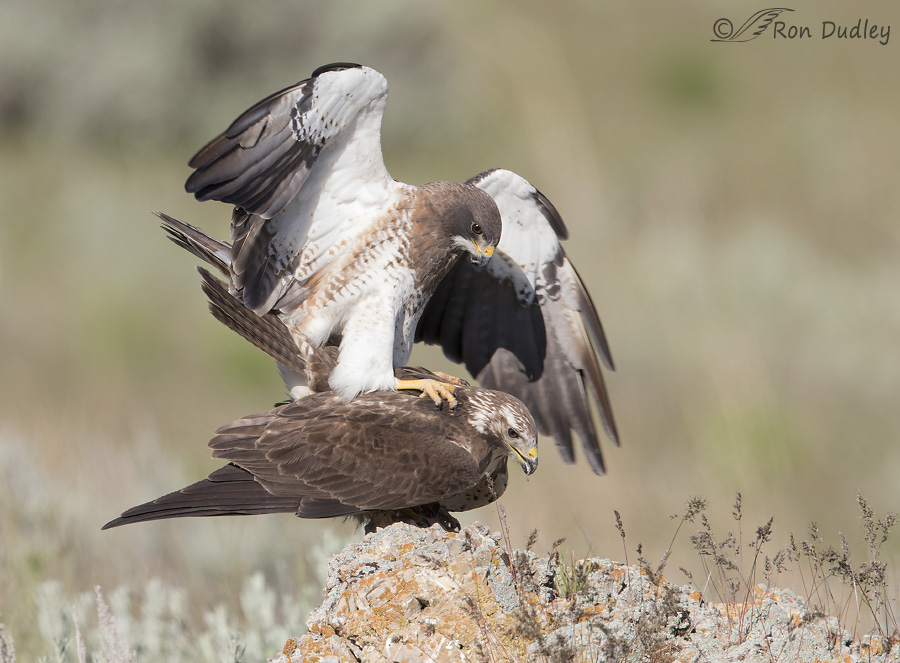
I believe the off-center landing was the beginning of the problems they had mating. The female has raised her left wing and the tail of the male has bisected it between her primaries and secondaries which made it very difficult if not impossible for the male to reach her cloacal opening with his own.
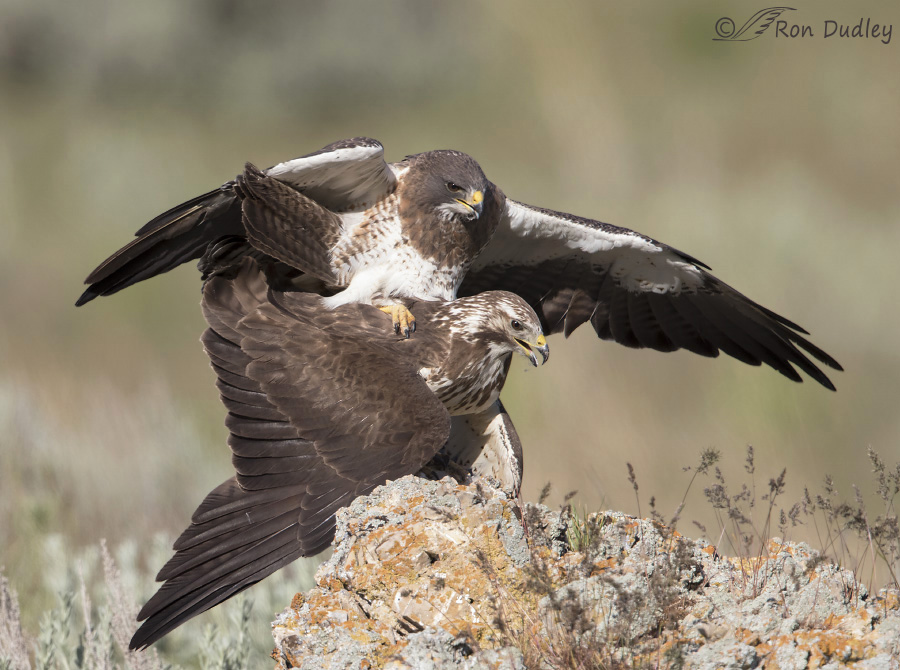
This is the single image of the behavior that I posted last week and many of us speculated about the origin of the feathers below the male’s right wing. Did they belong to the tail of the male or not? After studying this series of images (including others not posted here) I’m fairly confident that those feathers are the female’s left wing secondaries twisted to an unusual angle by the mutual activities of the hawks.
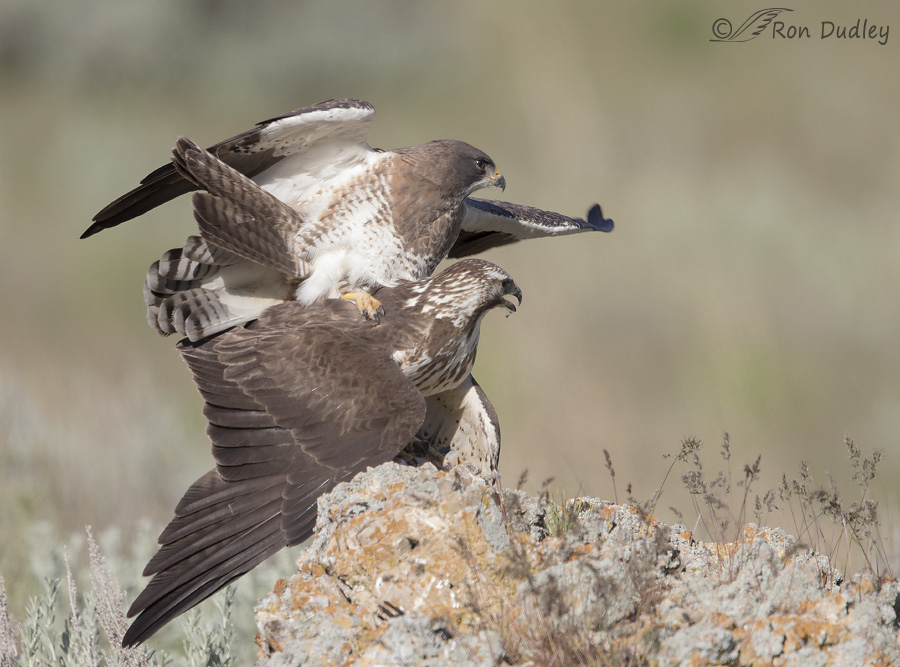
Both birds struggled for some time to consummate the act and at this point the male appears to be considering giving up in frustration and making his getaway but…
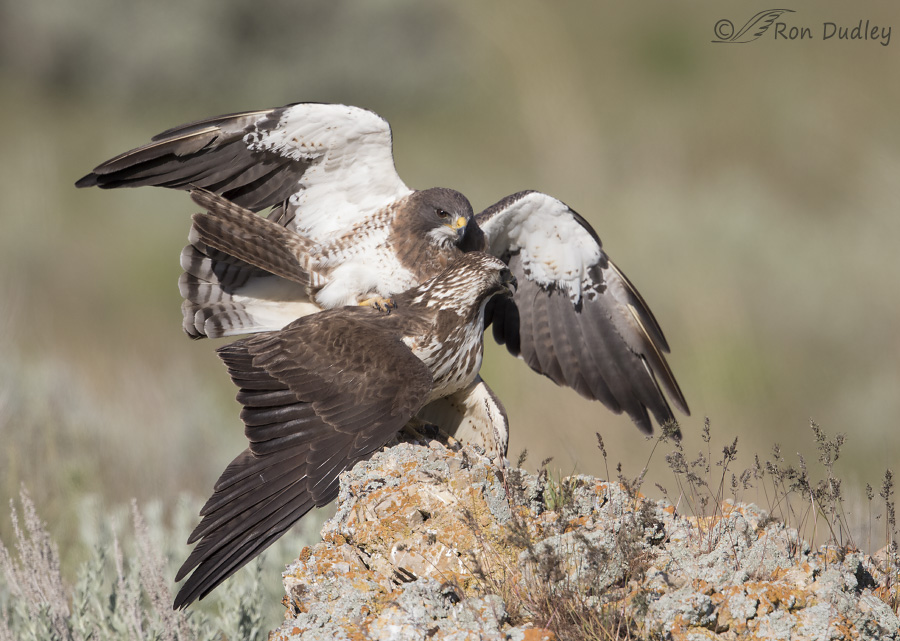
he apparently changed his mind and tried for a while longer.
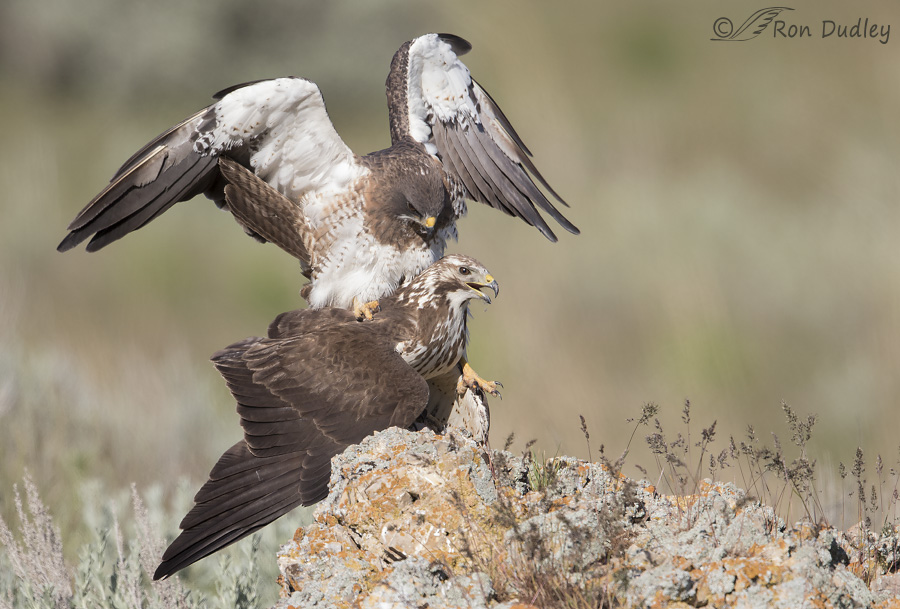
But eventually his left foot slipped off her back and landed on the crook of her wing. That twisted his body at a 90 degree angle to hers and made their goal even more difficult to achieve so…
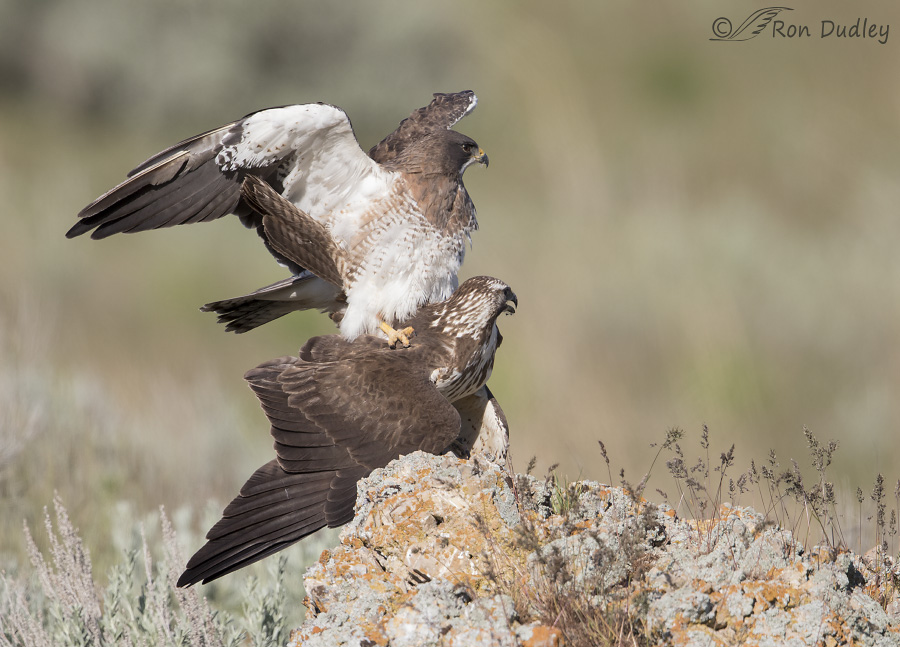
he gave up and flew off…
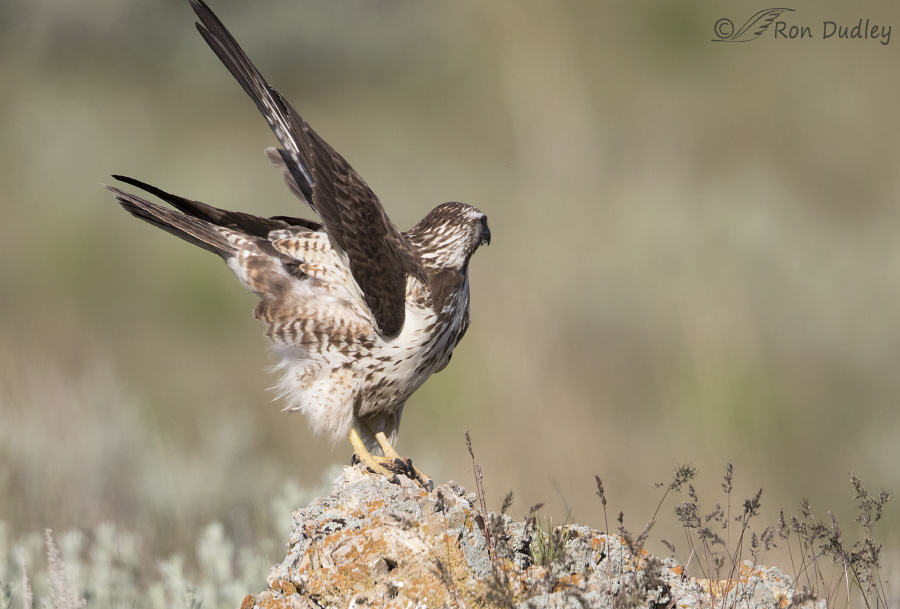
leaving the female behind to rearrange her wings and watch him as he departed.
But that isn’t the end of the story. I stayed with the female a while longer but what I didn’t know was that the male had other appetites he wanted to satisfy. When I eventually left the female and drove a short distance down the road something else unexpected was waiting for me.
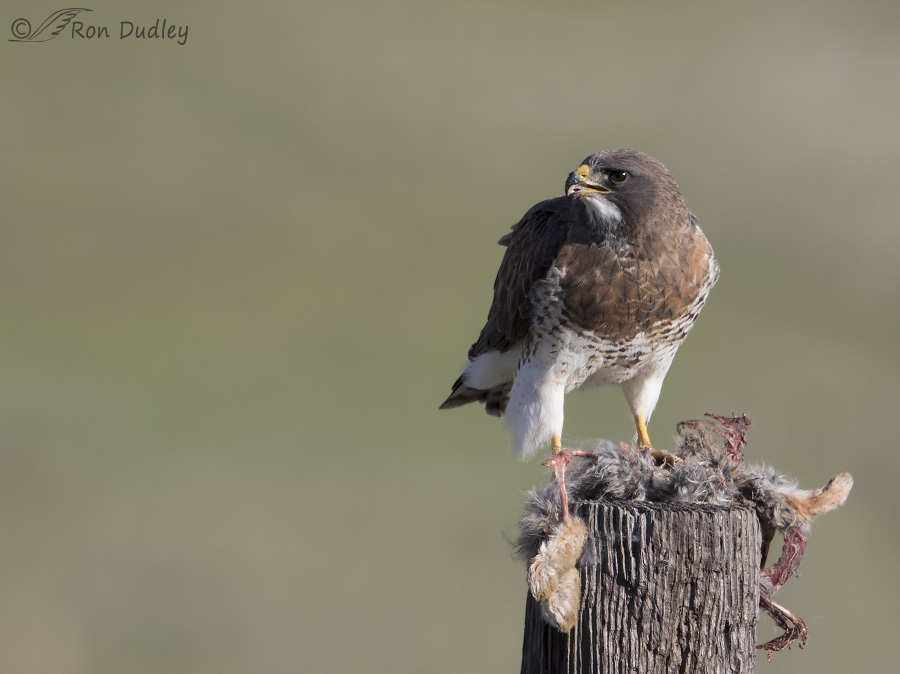
I found the male on top of a fence post (in bad side light) eating an obviously road-killed rabbit. Apparently he had flown with it from the road to the post and he was eating it enthusiastically. This surprised me. Though Swainson’s Hawks are known to eat rabbits I’ve only seen them eating voles and grasshoppers. I believe our local jackrabbits would be too large for these hawks to subdue or fly with (especially the smaller male) when they’re in pristine condition but this smashed rabbit had likely been fed on by the Turkey Vultures that are common in the area so it had lost much of its original mass.
The hawk fed on the rabbit for a long time but eventually his eating slowed and then stopped. When he took off some time later he carried the rabbit with him and landed with it…
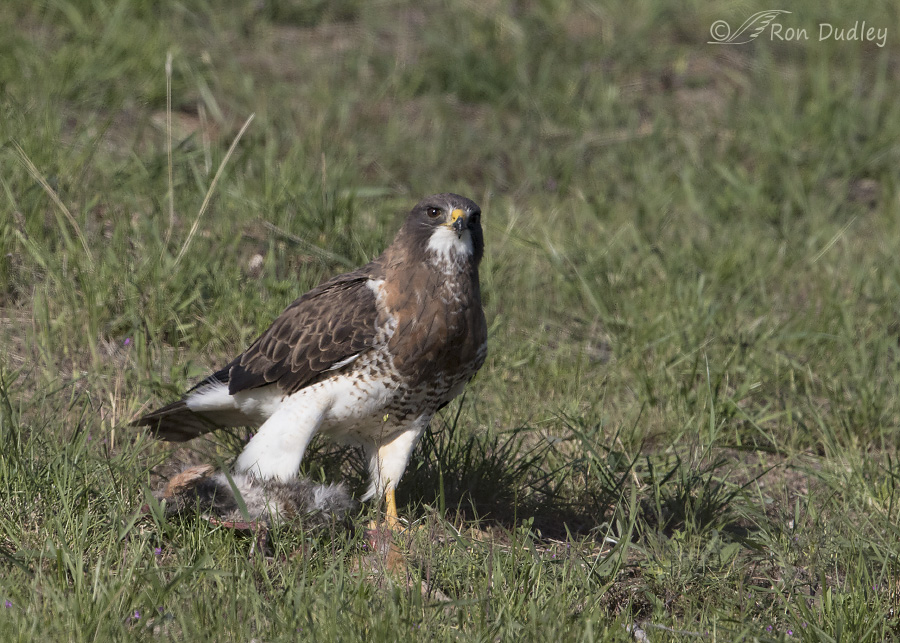
in a pasture across the road. Perhaps his intention was simply to stash the rabbit in a less conspicuous place because he didn’t eat any more of it…
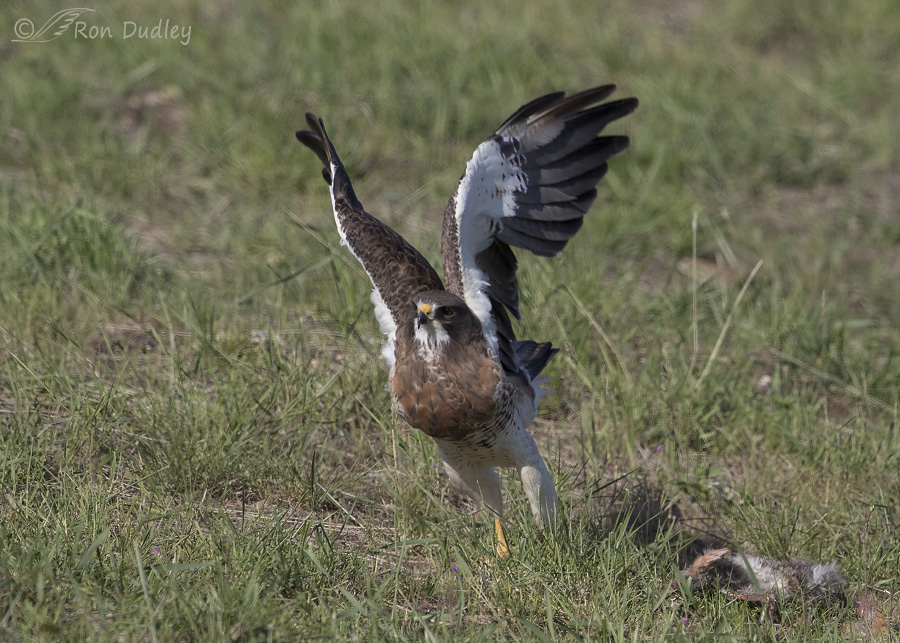
and soon left it behind. As you can see he definitely has a bulging crop.
I don’t believe that these hawks were successful in mating on this day but the next morning I saw them mating again atop a power pole. And it appears that the female is now incubating eggs in a nest near the top of a tree some distance away (I don’t closely approach nests).
I wish them luck in raising their family.
Ron
PS – Sorry about the lack of image techs this morning, I just didn’t have the time. But I will tell you about another bit of good fortune I had during the mating session. Just before the male unexpectedly flew in I had changed my aperture from f/6.3 to f/11 in an attempt to give me more depth of field to get more of the setting sharp. Later, during the attempted mating, I changed it to f/9. I believe these aperture settings allowed me to get better sharpness in both birds than I’d have been able to achieve at f/6.3. Another stroke of luck…
Here’s the tech range for most of the mating images: 1/640 – 1/1000, f/9 – f/11, ISO 400, Canon 7D Mark II, Canon EF 500mm f/4L IS II USM + 1.4 tc, not baited, set up or called in, all images taken from my pickup


I was very happy to become a bit of a voyeur this morning. And thrilled to hear that somehow a successful union took place.
I hope it was successful, EC. Thanks.
“If at first you don’t plant seed, try, try try again”…or something like that…..
Those images are amazing, thank you for sharing
Thanks, Carlotta.
Beautiful series, Ron! Thanks for documenting and sharing such a unique moment in time.
I’m glad you enjoyed it, Diane.
Super series, Ron. Wow!!! Never seen such perfect capture of action before and how good to learn something new.
Thanks very much, Tin.
I loved all the shots. It’s interesting to read all the comments about the male eating the roadkill. Made me think about some old movie….he’s out on the veranda having a smoke….
“he’s out on the veranda having a smoke….”
Carol, that made me think of Humphrey Bogart for some reason…
A very interesting series! It’s wonderful that you were able to see it up so close. I like the attitude of the male bird: if mating doesn’t work out, find something else pleasurable to do… This series brings home the point to me again, that birds are much more accepting of “what is” than us humans are. If things don’t work out, they just move on, they don’t sweat the small stuff. I also hope their new family does well.
“if mating doesn’t work out, find something else pleasurable to do”
That struck home with me (and made me smile), Susan. It’s a lesson I should have learned earlier when I was a young man…
Ron, I needed to come to that idea much earlier than I did, too. Thankfully, Mariah showed up in my mid-40s and taught me about that. Took a couple more years for me to GET it, then learn to operate the idea, but I’m reasonably good at it now.If something doesn’t work out, move on to something else (preferably something pleasurable!).
I don’t know how you do it, but you have certainly outdone yourself with this series!!
Fantastic series, wonderful storyline. I’m sure you will keep tabs on this nest throughout the season and we will see the progression of the young.
Behaviorally, with your observations, as i’ve said before, should be available to budding ornithologists. We should be all calling you professor!!
However, you have made a salient point here, with the hawk feeding on a rabbit that had already been fed on by Turkey Vultures. According to what I have read, Turkey Vultures tend to feed after the dead organism has begun to rot, because they have a symbiotic relationship with the decomposing bacteria that releases toxins in the carcass. This suggests that the hawk will not be affected by these toxins or the kill was new enough that the bacteria hadn’t had a chance to work on the carcass. If that is true, your findings certainly could add to the ornithological literature. I must say you are doing some very important stuff here Ron!
“I don’t know how you do it”
Thanks, Dick. I suspect that any success I have is largely related to how much time I spend in the field more than it is to any particular skill I may (or may not) have. If you spend enough time at it you eventually have to get lucky…
The number of road-killed rabbits in this area is amazing and it’s not even a very busy road. I’m sure that’s an indication of why there’s so many raptors, including vultures, in the vicinity.
Dick Harlow–first, I know redtails, not Swainson’s, however, you don’t find bones in a redtail’s casting. They digest them. I would GUESS that a digestive system that strong can kill the bacteria involved in eating roadkill sometimes. But bear in mind that I’m not an -ologist of any sort, nor do I play one on TV!
And Ron, it’s always a matter of being out there doing whatever it is you do, failing sometimes, but pushing through the failure to get to the win(s)!! You do that. You ROCK!
Laura,
I agree, but from what I understand part of the way Turkey Vultures, and I’m sure other vultures as well, compete for food is that they can deal with a 2-3 day old rotting corps whereas other scavengers may not be able to.
I just think the stuff Ron is finding out first hand is great and would add a lot to the Ornithological literature.
Hey Dick Harlow. Vultures can deal with food much older than that. Also, things like anthrax and rabies and other really bad pathogens don’t make it through their digestive tracts.
All the raptors will feed on older carcasses too, which is often how they get into trouble with lead poisoning from gut piles left in the field.
At the Cornell redtail hawk nest, the parents often let critters sit there for two or three days before feeding them to their little ones–bearing in mind that this time of year, the weather often acts as a natural refrigerator, too. Additionally, Ezra is a confirmed over-achiever when it comes to delivering food to the nest.
I did a VERY UNscientific test with a bunny behind last year (Operation Bunny Butt), recreating to my best ability what happens with the food over three days by putting the bunny behind on top of my weathering yard (a welded wire top). I found that it mostly dried (in more of a jerky context) than rotted and that the skin/fur/feathers provided some protection against the drying. However, after three days, the flies we’re doing their job. Last year was also significantly warmer than this year at this time. Heck, we had a killing frost last night for pity’s sake.
Anyway, I was just commenting that their digestive systems are pretty darn hardy.
Great series! Thanks for sharing.
Thanks, Judy.
Marvelous behavioral shots Ron!
Charlotte
Thank you, Charlotte.
What a spectacular series! I still can’t parse the feather arrangement in the one shot to my mind, so I’ll go with your explanation since I don’t have a better idea I just LOVE the shot of the incoming male with his brakes in full operation.
I just LOVE the shot of the incoming male with his brakes in full operation.
Like you, I suspect that the rabbit in question was leftover road kill, but even that works in a pinch with raptors. A full crop is a full crop, which is a good thing. Yes, Swainson’s can and do catch cottontails sometimes, but adult jackrabbits are probably out of the question (although I know better than to say it’s impossible). Young ones, however…
The light-morph female is interesting. I haven’t yet seen one of those (that I’m aware of) and I’m pretty sure I would have mis-IDed it if given the opportunity.
And yes, insert the ridiculously redundant OH WOW!
“I just LOVE the shot of the incoming male with his brakes in full operation”
I do too, Laura. I have more shots of him approaching in the background but I had to draw a line somewhere!
I agree, I just can’t imagine a Swainson’s taking on a healthy, adult jackrabbit. I’ve seen Golden Eagles in Montana have to work hard to take off with a jackrabbit.
Yes, jacks are tough customers. Redtails can do it, but I think it’s paramount for their survival that they learn the headshot in conjunction with grabbing those back legs with their other foot. Mariah learned that with her first jackrabbit at JFK Airport that took her for a major rodeo ride! The second and all other jacks were all nicely trussed up by the time I got to her! And that’s good news. A jack’s kick, placed properly in their chest, can kill a raptor.
You should see them with a sheep…or a cow…maybe a steer!!! Just ask a rancher……….
Great series, Ron and I believe you are correct about the feather arrangement! Nothing is easy for sure!
Nothing is easy for sure!  Beautiful with the male swooping in!
Beautiful with the male swooping in! 
“Nothing is easy for sure!”
Judy, this female is a young and presumably inexperienced bird so perhaps that had something to do with their difficulties mating.